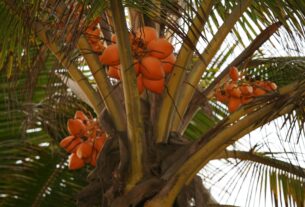Bamboo, known for its rapid growth and versatility, encompasses a wide variety of species, each with unique traits and uses. From towering giants that dominate landscapes to compact ground covers that add lush greenery to garden beds, bamboo plays essential roles in ecosystems and human activities. Ecologically, bamboo forests support biodiversity by providing critical habitats for wildlife, prevent soil erosion with their extensive root systems, and sequester significant amounts of carbon, making them powerful allies in combating climate change. For humans, bamboo is indispensable in construction due to its strength and flexibility, in crafts for its beauty and ease of use, and as a sustainable resource for products ranging from furniture to biodegradable utensils.
This article will explore some of the various bamboo species, highlighting their distinctive features and diverse applications. Whether providing wildlife habitats, enhancing soil stability, or serving as eco-friendly materials, bamboo is a plant of extraordinary importance and potential, shaping sustainable futures.
1. Giant Bamboo (Bambusa gigantea)
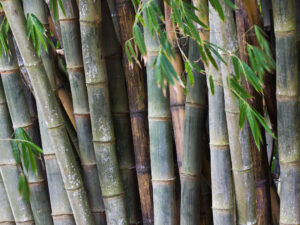
(flickr.com)
Giant Bamboo (Bambusa gigantea) is renowned for its remarkable size and strength, making it one of the most impressive bamboo species. Capable of growing up to 100 feet (30 meters) tall, this bamboo features culms with diameters reaching 6 inches (15 cm). Its robust and thick-walled stems give it an imposing presence, while its broad, lush leaves create a dense canopy. Native to tropical and subtropical climates, Giant Bamboo thrives in areas with well-drained soil and ample sunlight, where it can quickly establish itself and reach its full height.
The structural strength and durability of Giant Bamboo make it an invaluable material in construction. Its use in scaffolding is particularly significant in regions where traditional building materials are either costly or unavailable. The bamboo’s sturdy nature allows it to support substantial weight, making it suitable for both temporary and permanent structures. Additionally, its large size and resilience make it ideal for building robust and aesthetically pleasing furniture, such as tables and chairs, which benefit from the bamboo’s natural beauty and strength.
In addition to its role in construction and furniture making, Giant Bamboo plays a crucial role in environmental management. Its extensive root system is highly effective at preventing soil erosion and stabilizing land. By binding soil together, it helps to mitigate the risks associated with landslides and erosion on slopes and riverbanks. This makes Giant Bamboo an important plant for land reclamation and habitat restoration, particularly in areas prone to degradation due to heavy rainfall or deforestation.
Giant Bamboo’s versatility extends beyond practical applications to include decorative uses. Its impressive size and unique appearance make it a popular choice for large-scale decorative items, such as garden sculptures and architectural features. Whether used in construction, furniture making, environmental management, or art, Giant Bamboo exemplifies the diverse and valuable contributions this remarkable plant can offer.
2. Moso Bamboo (Phyllostachys edulis)
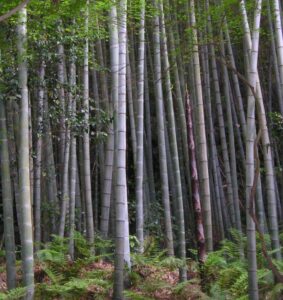
(wikipedia.org)
Moso Bamboo (Phyllostachys edulis) stands out as one of the most significant bamboo species, particularly noted for its impressive height and rapid growth. Native to China, this bamboo can reach up to 65 feet (20 meters) tall and develop culms with diameters of up to 7 inches (18 cm). Moso Bamboo’s towering stature and robust structure make it a dominant presence in bamboo forests. Its ability to grow rapidly in temperate climates makes it an ideal choice for various applications, providing both aesthetic and practical benefits.
The strength and flexibility of Moso Bamboo render it exceptionally useful in construction. It is commonly utilized for building frameworks, flooring, and even full structures, thanks to its durable and lightweight properties. This versatility allows Moso Bamboo to serve as a sustainable alternative to traditional construction materials such as timber and steel. Its inherent strength supports structural integrity, while its flexibility accommodates various architectural designs. Additionally, Moso Bamboo’s natural beauty adds an attractive element to construction projects, blending functionality with aesthetics.
In the paper industry, Moso Bamboo plays a crucial role due to its fast growth and high fiber content. The bamboo’s fibers are processed into pulp, which is then used to manufacture a range of paper products, from writing paper to cardboard. The rapid growth rate of Moso Bamboo ensures a steady supply of raw material, making it a sustainable choice for paper production. This contributes to reducing the reliance on slower-growing and less renewable resources, supporting environmental sustainability in the paper industry.
Beyond its industrial uses, Moso Bamboo is also valued in Asian cuisine for its tender shoots. These young shoots are harvested and consumed as a vegetable in various dishes, such as stir-fries and soups. Rich in vitamins and minerals, Moso Bamboo shoots offer a nutritious and crisp addition to culinary traditions in China, Japan, and Korea. Their popularity highlights the bamboo’s versatility, not only as a construction and manufacturing material but also as a valuable food source.
3. Black Bamboo (Phyllostachys nigra)
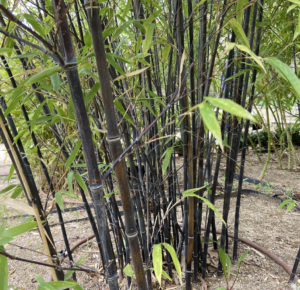
(commons.wikipedia)
Black Bamboo (Phyllostachys nigra) is a striking bamboo species renowned for its dramatic appearance. Characterized by its unique black-colored culms, Black Bamboo begins its life with green stems that gradually turn a deep, rich black as they mature. This transformation occurs over several years, making the bamboo an eye-catching feature in any landscape. Typically reaching heights of 20-30 feet (6-9 meters), Black Bamboo maintains a relatively modest stature compared to some larger bamboo species, but its distinctive color ensures it remains a focal point in garden settings.
The distinctive coloration of Black Bamboo makes it highly desirable in landscaping and ornamental gardening. Its dark, sleek stems provide a bold contrast against the greenery of other plants, creating a visually striking effect that can enhance the aesthetic appeal of outdoor spaces. Black Bamboo is often used to form privacy screens, hedges, or boundary markers, where its dense foliage and striking color provide both functional and decorative benefits. It is also effective in creating dramatic focal points within garden designs, adding a touch of elegance and sophistication to various garden themes.
Beyond its ornamental uses, Black Bamboo is valued for its applications in crafts and furniture making. The bamboo’s smooth, dark-colored culms are ideal for creating a range of decorative items, from intricately designed bamboo art to unique garden ornaments. Craftsmen appreciate its strength and workability, allowing for the production of high-quality, visually appealing pieces. In furniture design, Black Bamboo is used to make elegant and durable items such as tables, chairs, and shelves, where its rich color and natural beauty contribute to sophisticated, stylish interiors.
Overall, Black Bamboo’s blend of beauty and functionality makes it a versatile plant with a range of applications. Its striking appearance enhances landscaping and garden designs, while its durability and aesthetic appeal make it a popular choice for crafts and furniture. Black Bamboo’s unique attributes underscore its value as a multifaceted plant that offers both visual interest and practical benefits.
4. Buddha’s Belly Bamboo (Bambusa ventricosa)
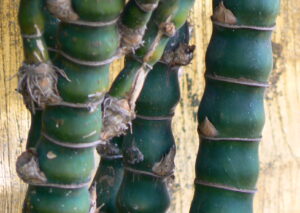
(flickr.com)
Buddha’s Belly Bamboo (Bambusa ventricosa) is renowned for its distinctive and charming appearance, characterized by swollen, bulbous nodes that resemble a Buddha’s belly. This unique feature gives the bamboo a sculptural quality that sets it apart from other varieties. Typically reaching heights of about 30 feet (9 meters) and a diameter of 2 inches (5 cm), Buddha’s Belly Bamboo maintains a moderate size that enhances its ornamental value. The bamboo’s striking appearance is particularly notable as the nodes become more pronounced with age, adding a touch of whimsy and elegance to its overall form.
The primary use of Buddha’s Belly Bamboo is in ornamental gardening and landscaping. Its unique, bulbous nodes make it a standout choice for decorative plantings, where it serves as a focal point or a conversation piece. Gardeners and landscape designers often use this bamboo to create eye-catching garden features, such as decorative borders, privacy screens, or statement plantings. The plant’s distinctive shape and lush foliage contribute to its role as a central element in garden designs, adding an exotic and artistic touch to outdoor spaces.
In addition to its decorative uses, Buddha’s Belly Bamboo is also employed in various landscape design elements. Its dense growth habit and unique form make it suitable for creating visual interest and texture in garden settings. The bamboo’s unusual shape can be used to complement other plants or structures, enhancing the overall aesthetic of garden layouts. Whether used in traditional or contemporary garden designs, Buddha’s Belly Bamboo provides a blend of natural beauty and artistic expression.
Overall, Buddha’s Belly Bamboo’s captivating appearance and ornamental value make it a cherished plant in landscape design. Its unique bulbous nodes and moderate growth size allow it to be a standout feature in gardens and landscaping projects. By incorporating Buddha’s Belly Bamboo, gardeners can achieve a blend of natural beauty and artistic expression, enhancing the overall aesthetic of outdoor spaces.
5. Dwarf Bamboo (Pleioblastus pygmaeus)
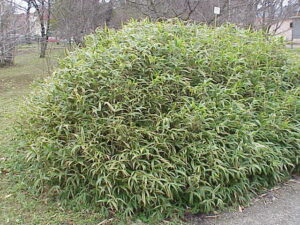
(commons.wikipedia)
Dwarf Bamboo (Pleioblastus pygmaeus) is a delightful bamboo species renowned for its compact size and dense growth habit. Typically reaching a height of just 2-3 feet (0.6-1 meter), this low-growing bamboo forms a lush, ground-covering mat that adds a touch of greenery to small garden spaces. Its compact stature makes it an excellent choice for areas where space is limited, providing an attractive, dense carpet of foliage without overwhelming the surrounding environment.
One of the primary applications of Dwarf Bamboo is as ground cover in gardens. Its ability to spread densely helps to suppress weeds, control erosion, and provide a continuous green layer that enhances the visual appeal of garden beds. The bamboo’s dense foliage creates a soft, cushiony effect, which can be particularly beneficial in shaded areas where other ground covers might struggle. This low-maintenance plant is ideal for creating a neat, uniform appearance in garden design, contributing to a polished and well-maintained look.
In addition to its use in ground cover, Dwarf Bamboo is also a popular choice for container gardening. Its small size makes it well-suited for growing in pots and planters, where it can add a touch of greenery to patios, balconies, or even indoor spaces. Container gardening with Dwarf Bamboo allows for flexible placement and arrangement, making it a versatile option for adding visual interest and texture to various settings. The bamboo’s compact growth ensures that it remains tidy and attractive even in confined spaces.
Overall, Dwarf Bamboo’s combination of compact size and dense growth makes it a valuable addition to a range of gardening and landscaping scenarios. Whether used as ground cover, in container gardening, or as a decorative element, its ability to provide a lush, green carpet and its low-maintenance nature make it a favored choice for enhancing garden spaces. Its adaptability and aesthetic appeal ensure that Dwarf Bamboo remains a popular option for both novice and experienced gardeners.
6. Japanese Timber Bamboo (Phyllostachys bambusoides)
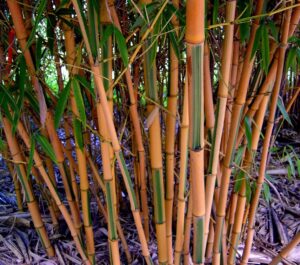
(flickr.com)
Japanese Timber Bamboo (Phyllostachys bambusoides) stands out for its impressive size and remarkable strength. Characterized by its straight, upright growth, this bamboo can reach heights of up to 60 feet (18 meters) and achieve a diameter of 3-4 inches (8-10 cm). Its robust, dense culms provide an exceptional combination of height and durability, making it a preferred choice for various structural applications. The bamboo’s straight, thick-walled stems are not only aesthetically striking but also highly functional, contributing to its broad range of uses.
In Japan, Japanese Timber Bamboo is a staple in construction due to its exceptional strength and versatility. Historically, it has been employed in building everything from traditional Japanese houses to modern structures. The bamboo’s resilience under stress and its natural flexibility make it ideal for creating scaffolding, bridges, and fences. Additionally, its durability allows it to withstand environmental challenges, making it a reliable material for both structural and decorative purposes. The bamboo’s traditional use in construction reflects its importance in Japanese architectural practices and cultural heritage.
Beyond construction, Japanese Timber Bamboo is also integral to traditional crafts and cultural practices. Artisans use it to create a variety of handcrafted items, including decorative elements for gardens, bamboo poles for traditional Japanese ceremonies, and intricate tools. The bamboo’s ability to be finely manipulated while maintaining strength and flexibility makes it suitable for detailed craftsmanship. Its use in these traditional contexts highlights its cultural significance and enduring role in Japanese artistry and heritage.
Overall, Japanese Timber Bamboo’s combination of impressive size, strength, and versatility underscores its value in both practical and cultural applications. Its role in construction demonstrates its structural capabilities, while its use in traditional crafts reflects its deep cultural roots. By offering durability and aesthetic appeal, Japanese Timber Bamboo continues to be a treasured material, bridging historical practices with contemporary needs.
7. Yellow Groove Bamboo (Phyllostachys aureosulcata)
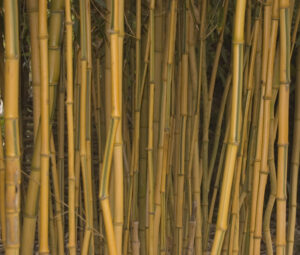
(commons.wikipedia)
Yellow Groove Bamboo (Phyllostachys aureosulcata) is renowned for its distinctive visual appeal, marked by striking yellow stripes or grooves along its culms. This bamboo species can reach impressive heights of up to 30 feet (9 meters), with its vibrant coloration providing a unique contrast against green foliage. The bold yellow stripes are particularly eye-catching and contribute to its popularity as an ornamental plant. This bamboo’s aesthetic appeal makes it a standout feature in garden landscapes, where its colorful appearance can add both texture and interest to outdoor spaces.
In landscaping, Yellow Groove Bamboo is favored for its ornamental value and versatility. Its dramatic yellow-striped culms can create stunning visual effects in various garden settings. It is often used as a focal point or as part of a garden’s design to add a splash of color and texture. Its upright, dense growth makes it an excellent choice for privacy screens, garden borders, and decorative accents. Additionally, its adaptability to a range of climates allows it to thrive in diverse environmental conditions, making it a flexible choice for different landscape styles.
Beyond its visual appeal, Yellow Groove Bamboo also serves practical purposes in construction. Its strong and durable culms are suitable for a range of structural applications, including fencing, trellises, and garden supports. The bamboo’s resilience and sturdiness make it a dependable material for building functional and aesthetically pleasing outdoor features. Its combination of strength and beauty ensures that it can be used effectively in both residential and commercial projects, where it meets both structural and decorative needs.
Overall, Yellow Groove Bamboo’s unique appearance and practical uses make it a valuable addition to both landscaping and construction. Its eye-catching yellow stripes provide a distinctive touch to garden designs, while its durability and adaptability offer functional benefits in various applications. By blending beauty with utility, Yellow Groove Bamboo continues to be a popular choice for enhancing outdoor environments.
8. Kuruna Bamboo (Bambusa oldhamii)
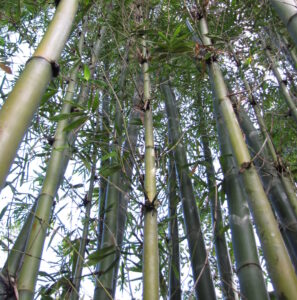
(commons.wikipedia)
Kuruna Bamboo (Bambusa oldhamii), native to Taiwan, is renowned for its impressive height and smooth, green stems. Reaching up to 40 feet (12 meters) tall with a diameter of around 3 inches (8 cm), this bamboo species is celebrated for its rapid growth rate and striking appearance. Its tall, straight culms are covered in a sleek green skin that adds a lush, vibrant element to any landscape. This aesthetic appeal, combined with its fast growth, makes Kuruna Bamboo a popular choice for various decorative and functional uses.
In construction, Kuruna Bamboo is highly valued for its strength and versatility. The bamboo’s robust and durable nature allows it to be used in structural applications such as building supports, poles, and scaffolding. Its smooth, straight stems are ideal for creating sturdy frameworks, and its rapid growth ensures a consistent supply of material. The bamboo’s resilience under stress makes it suitable for both residential and commercial construction projects, where its functional benefits are complemented by its attractive appearance.
Kuruna Bamboo is also widely utilized in furniture making. Its strong, smooth stems can be crafted into a variety of furniture items, including chairs, tables, and decorative accents. The bamboo’s natural finish and easy workability make it an excellent choice for creating stylish, durable furniture. Additionally, its fast growth rate supports sustainable production practices, providing a renewable resource for designers and manufacturers who prioritize eco-friendly materials.
Moreover, Kuruna Bamboo is an effective solution for creating privacy screens in gardens. Its dense, upright growth forms a natural barrier that enhances privacy and seclusion in outdoor spaces. The bamboo’s ability to establish a screen quickly makes it ideal for gardeners seeking both immediate results and long-term benefits. By combining aesthetic appeal with practical applications, Kuruna Bamboo proves to be a versatile and valuable plant for enhancing both functional and decorative aspects of landscaping and construction.
9. Red Margin Bamboo (Fargesia murielae)

(commons.wikipedia)
Red Margin Bamboo (Fargesia murielae) is a captivating clumping bamboo species renowned for its elegant stature and distinctive features. Typically reaching heights of 8-12 feet (2.5-4 meters), this bamboo is celebrated for its narrow leaves and striking culms, which are adorned with a unique red margin. This eye-catching red edge enhances its visual appeal, making it a standout choice for ornamental purposes in garden and landscape design. The bamboo’s graceful appearance and vibrant coloring add a touch of sophistication to any outdoor space, setting it apart from more common bamboo varieties.
In temperate regions, Red Margin Bamboo is particularly prized for its ornamental value. Its clumping growth habit ensures that it maintains a compact form while still achieving a notable height, making it perfect for garden beds and decorative plantings. The bamboo’s slender, elegant leaves and colorful culms contribute to its refined look, making it a favorite among gardeners who seek to enhance the aesthetic appeal of their landscapes. Its ability to blend seamlessly into various garden styles—from modern minimalist to traditional lush gardens—makes it a versatile choice for a range of design preferences.
Beyond its ornamental uses, Red Margin Bamboo is also valued for its effectiveness as a privacy hedge. Its dense, upright growth forms a natural barrier that provides excellent screening and seclusion in outdoor areas. The bamboo’s clumping nature ensures that it does not spread aggressively, making it an ideal option for creating a manageable and aesthetically pleasing privacy screen. Whether used to enclose garden spaces, separate different areas of a landscape, or block unsightly views, Red Margin Bamboo offers both functionality and beauty.
Overall, Red Margin Bamboo’s combination of visual charm and practical benefits makes it a valuable addition to garden and landscape projects. Its distinctive red-edged culms and elegant foliage enhance garden designs, while its clumping growth provides effective privacy solutions. By incorporating Red Margin Bamboo into outdoor spaces, gardeners and landscapers can achieve a harmonious balance of beauty and functionality.
10. Green Bamboo (Phyllostachys aurea)

(flickr.com)
Green Bamboo (Phyllostachys aurea), commonly known as Golden Bamboo, is a captivating clumping bamboo species renowned for its vibrant green culms and dense growth habit. Typically growing to heights of 10-20 feet (3-6 meters), this bamboo creates a lush, compact clump that adds an elegant touch to various landscapes. The bamboo’s bright green stems and thick foliage make it a striking addition to gardens, contributing to a rich, verdant aesthetic that enhances outdoor spaces with its natural beauty.
One of Green Bamboo’s primary uses is in creating effective hedges and screens. Its dense, upright growth forms a solid, natural barrier that offers excellent privacy and wind protection. This makes it an ideal choice for gardeners looking to enclose outdoor areas, separate different sections of a garden, or shield their property from view. The bamboo’s ability to maintain a compact form while providing substantial coverage ensures that it remains manageable and aesthetically pleasing, making it a versatile option for privacy solutions in a variety of settings.
In addition to its practical uses, Green Bamboo is highly valued for its visual appeal. The bamboo’s vibrant green culms and dense foliage create a lush, tropical ambiance, adding a touch of greenery that complements various garden styles. Its clumping growth habit ensures that it remains contained and does not spread aggressively, making it suitable for smaller gardens as well as larger landscapes. This versatility allows Green Bamboo to blend seamlessly into contemporary, traditional, or eclectic garden designs, enhancing the overall visual impact of outdoor spaces.
Overall, Green Bamboo’s combination of dense foliage, striking appearance, and practical benefits makes it a valuable addition to landscape projects. Its vibrant green stems and effective privacy screen capabilities provide both aesthetic and functional advantages, enriching garden designs and offering practical solutions for creating secluded and visually appealing environments. By incorporating Green Bamboo into landscaping efforts, gardeners and designers can achieve a balanced blend of beauty and utility, enhancing outdoor spaces with its elegant and versatile qualities.
Conclusion,
Bamboo, with its remarkable diversity and adaptability, stands as a testament to nature’s ingenuity. From towering giants like Giant Bamboo to the compact beauty of Dwarf Bamboo, each species offers unique characteristics and benefits. Ecologically, bamboo plays a crucial role in supporting biodiversity, preventing soil erosion, and sequestering carbon, contributing significantly to environmental conservation and climate change mitigation. For humans, bamboo’s versatility is unparalleled, providing sustainable materials for construction, crafts, food, and numerous eco-friendly products.
As we continue to explore and harness the potential of various bamboo species, it becomes clear that this extraordinary plant is more than just a part of the landscape. It is a vital resource for sustainable development, offering solutions to some of the most pressing ecological and economic challenges of our time. By understanding and utilizing the diverse species of bamboo, we can foster a more sustainable and harmonious relationship with our environment, ensuring a greener future for generations to come.











